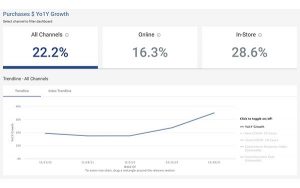Interactive video is an innovative approach to marketing that can increase audience engagement, especially among millennials. Major brands like Toyota, Warner Bros. Pictures, and Deloitte are beginning to catch on, dipping their toes into the sea of possibilities this technology represents.
Still, many in marketing and advertising remain in the dark about the opportunities interactive offers and how to best leverage its capabilities, including data and customer insights. Although interactive video is getting easier to create, marketers and advertisers still struggle to understand how it works and how they can leverage it for their brands.
Should interactive video be part of your strategy this year? And if so, what do you need to know to reach your goals? Here’s a guide to what marketers and advertisers need to know about interactive video in order to take the plunge.
Interactive experiences increase engagement
Brands are putting more and more content on the Web, increasing competition for consumers’ mental bandwidth, thereby lowering the odds of any meaningful engagement. At Rapt Media, we’ve found that interactive video, which drives up to three times more engagement than traditional video, offers a way to stand out in the sea of content.
Creating an immersive and tailored experience leads to longer view times, increased interactions, and more social sharing, which is exactly what content creators are looking for in 2016. According to a Content Marketing Institute report, creating more engaging content is a priority for 72 percent of content creators this year.
In a recent Brightcove survey of B2B and B2C marketers already using interactive video, 70 percent say that this medium engages well or very well. In fact, driving better engagement was the top reason respondents turned to interactive video in the first place.
Interactive video prioritizes consumer choice
When people watch a traditional marketing video, the type of video we’ve all been watching for several decades, they’re forced to consume whatever message the brand wants to push, whether or not it applies to or interests them. With interactive video, people can choose what’s relevant to them, and consumers are beginning to demand this type of personalization as part of their experience. For example, according to Rapt Media’s Power of Choice report, 34 percent of video consumers want the option of being able to jump to a different part of a video.
Toyota is one brand responding to consumer preferences in this area. In Choose Your Wild, Toyota’s recent video promotion for the 4Runner, viewers can choose to be a couch potato or an adventurer; it’s a simple proposition but holds great potential for user engagement. Once viewers choose from the initial offering, they’re then given more options to continue the experience.

Interactive video boosts ROI
Not only does interactive video bring higher engagement rates, it can also increase conversions and sales, which are essential KPIs for digital marketers to prove return on investment. We have found that videos with choice can have three times the viewing times, two times the conversions, and 14 times the click-through-to-purchase rates. In addition, Rapt Media found in its “Power of Choice” report that 64 percent of consumers are more likely to spend more time watching video if they’re given more options to interact with it.
Brands are spending more and more on mobile video ads. In fact, mobile video ad revenue in the U.S. will top over $ 4.4 billion in 2018. Interactive video can carry a higher return on that investment compared to traditional advertising. B2B content marketers’ ability to accelerate their lead lifecycle as a direct result of personalized content and increased engagement is another example illustrating increased ROI from interactive video.

Interactive video is getting easier to produce
While it’s true that creating an interactive video experience once required considerable time, effort and resources, technology is now making it relatively easy. And marketers are noticing. About 25 percent of respondents in the Brightcove survey said that creating and deploying interactive videos was difficult or very difficult. But twice that number said it was easy or very easy.
A number of companies offering interactive video technologies — including HapYak, SnapApp, Interlude and Wirewax — are simplifying the creation, publication, measurement and optimization of interactive content through their platform technologies. More and more content marketers are experiencing the ease of these technologies and realizing that it is not necessary to build proprietary solutions.
By 2019, video is likely to make up 80 percent of all Internet traffic. In this competitive landscape, interactive experiences will help set brands apart. Marketers and advertisers may still be somewhat mystified by interactive video, but that’s unlikely to last much longer. As they begin to see results from interactive video, this particular type of content will grow in popularity.
The bottom line: interactive video isn’t a fad or gimmick — it’s a viable medium that helps increase engagement and drive meaningful connections with their audiences while driving data and insights that support return on investment calculation. Soon, interactive video will go from a “nice to have” to a “must-have,” and brands that don’t include the medium in their marketing strategy will find themselves left behind.
Digital & Social Articles on Business 2 Community(84)





